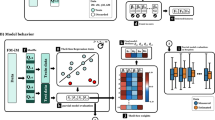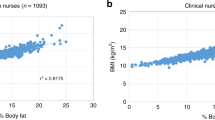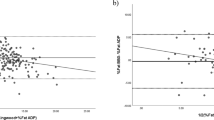Abstract
Background/objectives:
Prediction equations are commonly used to estimate body fat from anthropometric measurements, but are population specific. We aimed to establish and validate a body composition prediction formula for Asian newborns, and compared the performance of this formula with that of a published equation.
Subjects/methods:
Among 262 neonates (174 from day 0, 88 from days 1–3 post delivery) from a prospective cohort study, body composition was measured using air-displacement plethysmography (PEA POD), with standard anthropometric measurements, including triceps and subscapular skinfolds. Using fat mass measurement by PEA POD as a reference, stepwise linear regression was utilized to develop a prediction equation in a randomly selected subgroup of 62 infants measured on days 1–3, which was then validated in another subgroup of 200 infants measured on days 0–3.
Results:
Regression analyses revealed subscapular skinfolds, weight, gender and gestational age were significant predictors of neonatal fat mass, explaining 81.1% of the variance, but not triceps skinfold or ethnicity. By Bland–Altman analyses, our prediction equation revealed a non-significant bias with limits of agreement (LOA) similar to those of a published equation for infants measured on days 1–3 (95% LOA: (−0.25, 0.26) kg vs (−0.23, 0.21) kg) and on day 0 (95% LOA: (−0.19, 0.17) kg vs (−0.17, 0.18) kg). The published equation, however, exhibited a systematic bias in our sample.
Conclusions:
Our equation requires only one skinfold site measurement, which can significantly reduce time and effort. It does not require the input of ethnicity and, thus, aid its application to other Asian neonatal populations.
This is a preview of subscription content, access via your institution
Access options
Subscribe to this journal
Receive 12 print issues and online access
$259.00 per year
only $21.58 per issue
Buy this article
- Purchase on Springer Link
- Instant access to full article PDF
Prices may be subject to local taxes which are calculated during checkout


Similar content being viewed by others
References
Lean ME . Pathophysiology of obesity. Proc Nutr Soc 2000; 59: 331–336.
Andres A, Gomez-Acevedo H, Badger TM . Quantitative nuclear magnetic resonance to measure fat mass in infants and children. Obesity 2011; 19: 2089–2095.
Urlando A, Dempster P, Aitkens S . A new air displacement plethysmography for the measurement of body composition in infants. Pediatr Res 2003; 53: 486–492.
Sainz RD, Urlando A . Evaluation of a new pediatric air-displacement plethysmograph for body composition assessment by means of chemical analysis of bovine tissue phantoms. Am J Clin Nutr 2003; 77: 364–370.
Yao M, Nommsen-Rivers L, Dewey KG, Urlando A . Preliminary evaluation of a new pediatric air displacement plethysmograph for body composition assessment in infants. Acta Diabetol 2003; 40: 55–58.
Fields DA, Goran MI . Body composition techniques and the four-compartment model in children. J Appl Physiol 2000; 89: 613–620.
Ellis KJ, Yao M, Shypailo RJ, Urlando A, Wong WW, Heird WC . Body composition assessment in infancy: air-displacement plethysmography compared with a reference 4-compartment model. Am J Clin Nutr 2007; 85: 90–95.
Ma G, Yao M, Liu Y, Lin A, Zou H, Urlando A et al. Validation of a new pediatric air-displacement plethysmograph for assessing body composition in infants. Am J Clin Nutr 2004; 79: 653–660.
Lohman TG . Assessment of body composition in children. Pediatr Exerc Sci 1989; 1: 19–30.
Wells JC, Fuller NJ, Dewit O, Fewtrell MS, Elia M, Cole TJ . Four-component model of body composition in children: density and hydration of fat-free mass and comparison with simpler models. Am J Clin Nutr. 1999; 69: 904–912.
Weststrate JA, Deurenberg P . Body composition in children: proposal for a method for calculating body fat percentage from total body density or skinfold-thickness measurements. Am J Clin Nutr 1989; 50: 1104–1115.
Forbes GB . Human Body Composition. Springer Verlag: New York, 1987.
Fidanza F . Nutritional Status Assessment. Chapman & Hall: London, New York, Tokyo, Melbourne, Madras, 1991.
Kehoe SH, Krishnaveni GV, Lubree HG, Wills AK, Guntupalli AM, Veena SR et al. Prediction of body-fat percentage from skinfold and bio-impedance measurements in Indian school children. Eur J Clin Nutr 2011; 65: 1263–1270.
Rodriguez G, Moreno LA, Blay MG, Blay VA, Fleta J, Sarria A et al. Body fat measurement in adolescents: comparison of skinfold thickness equations with dual-energy X-ray absorptiometry. Eur J Clin Nutr 2005; 59: 1158–1166.
Sheng HP, Muthappa PB, Wong WW, Schanler RJ . Pitfalls of body fat assessments in premature infants by anthropometry. Biol Neonate 1993; 64: 279–286.
Goran MI, Driscoll P, Johnson R, Nagy TR, Hunter G . Crosscalibration of body-composition techniques against dual-energy X-ray absorptiometry in young chilrden. Am J Clin Nutr 1996; 63: 299–305.
Davies PS, Lucas A . The prediction of total body fatness in early infancy. Early Hum Dev. 1990; 21: 193–198.
Lohman TG . Advances in body composition assessment. Med Sci Sports Exerc 1993; 25: 762.
Slaughter MH, Lohman TG, Boileau RA, Horswill CA, Stillman RJ, Van Loan MD et al. Skinfold equations for estimation of body fatness in children and youth. Hum Biol 1988; 60: 709–723.
Norgan NG . The assessment of the body composition of populations. In: Davies PSW, Cole TJ, (eds). Body Composition Techniques in Health and Disease. Cambridge University Press: Cambridge, 195–221, 1995.
Hawkes CP, Hourihane JO, Kenny LC, Irvine AD, Kiely M, Murray DM . Gender- and gestational age-specific body fat percentage at birth. Pediatrics 2011; 128: e645–e651.
Hull HR, Thornton JC, Ji Y, Paley C, Rosenn B, Mathews P et al. Higher infant body fat with excessive gestational weight gain in overweight women. Am J Obstet Gynecol 2011; 205: 211.e1–7.
Jackson AS, Pollock ML . Generalized equations for predicting body density of men. Br J Nutr 1978; 40: 497–504.
Jackson AS, Pollock ML . Generalized equations for predicting body density of women. Med Sci Sports Exerc 1980; 12: 175–182.
Leppik A, Jurimae T, Jurimae J . Reproducibility of anthropometric measurements in children: a longitudinal study. Anthropol Anz 2004; 62: 79–91.
Schaefer F, Georgi M, Zieger A, Scharer K . Usefulness of bioelectric impedance and skinfold measurements in predicting fat-free mass derived from total body potassium in children. Pediatr Res 1994; 35: 617–624.
Altman DG, Bland JM . Measurement in Medicine: The Analysis of Method Comparison Studies. Journal of the Royal Statistical Society. J R Stat Soc Ser D 1983; 32: 307–317.
Himes JH, Roche AF, Webb P . Fat areas as estimates of total body fat. Am J Clin Nutr. 1980; 33: 2093–2100.
Lingwood BE, Storm van Leeuwen AM, Carberry AE, Fitzgerald EC, Callaway LK, Colditz PB et al. Prediction of fat-free mass and percentage of body fat in neonates using bioelectrical impedance analysis and anthropometric measures: validation against the PEA POD. Br J Nutr 2012; 107: 1545–1552.
Deierlein AL, Thornton J, Hull H, Paley C, Gallagher D . An anthropometric model to estimate neonatal fat mass using air displacement plethysmography. Nutr Metab 2012; 9: 21.
Schmelzle HR, Fusch C . Body fat in neonates and young infants: validation of skinfold thickness versus dual-energy X-ray absorptiometry. Am J Clin Nutr 2002; 76: 1096–1100.
Mueller WH, Malina RM . Relative reliability of circumferences and skinfolds as measures of body fat distribution. Am J Phys Anthropol 1987; 72: 437–439.
Deurenberg P, Deurenberg-Yap M . Validity of predicted body fat from skinfolds in Singaporean Chinese, Malays and Indians. Int J Body Comp Res 2003; 1: 23–30.
Deurenberg-Yap M, Ng SA, Foo LL, Deurenberg P . Development and validation of a prediction equation for body fat percent based on skinfolds in Singaporean adults and adolescents. Int J Body Comp Res 2003; 1: 103–109.
Michaelsen KF, Skov L, Badsberg JH, Jorgensen M . Short-term measurement of linear growth in preterm infants: validation of a hand-held knemometer. Pediatr Res 1991; 30: 464–468.
Durnin JVGA, Womersley J . Body fat assessed from total body density and its estimation from skinfold thickness: measurements on 481 men and women aged from 17 to 72 years. Brit J Nutr 1974; 32: 77–97.
van Lenthe FJ, Kemper HC, van Mechelen W, Twisk JW . Development and tracking of central patterns of subcutaneous fat in adolescence and adulthood: the Amsterdam Growth and Health Study. Int J Epidemiol 1996; 25: 1162–1171.
Acknowledgements
We acknowledge our fellow investigators of the GUSTO study group: Dennis Bier, Arijit Biswas, Cai Shirong, Helen Chan, Jerry Chan, Yiong Huak Chan, Cornelia Chee, Audrey Chia, Chiang Wen Chin, Chng Chai Kiat, Mary Chong, Chong Shang Chee, Chua Mei Chien, Wayne Cutfield, Mary Daniel, Ding Chun Ming, Anne Ferguson-Smith, Eric Andrew Finkelstein, Marielle Fortier, Doris Fok, Anne Goh, Daniel Goh, Joshua J Gooley, Han Wee Meng, Mark Hanson, Mikael Hartman, Michael Heymann, Stephen Hsu Chin-Ying, Hazel Inskip, Jeevesh Kapur, Joanna Holbrook, Lee Bee Wah, BFP Leutscher-Broekman, Lim Sok Bee, Loh Seong Feei, Low Yen Ling, Iliana Magiati, Susan Morton, Krishnamoorthy N, Cheryl Ngo, Pang Wei Wei, Prathiba Agarwal, Qiu Anqi, Quah Boon Long, Victor S Rajadurai, Jen Richmond, Anne Rifkin-Graboi, Allan Sheppard, Lynette Pei-Chi Shek, Borys Shuter, Leher Singh, So Wing Chee, Walter Stunkel, Su Lin Lin, Tan Kok Hian, Tan Soek Hui, Teoh Oon Hoe, Terry Yoke Yin Tong, Hugo Van Bever, Rob Van Dam, Sudhakar Venkatesh, Helena Marieke Verkooijen, Inez By Wong, PC Wong and George SH Yeo. This study is under the Translational Clinical Research (TCR) Flagship Programme on Developmental Pathways to Metabolic Disease, NMRC/TCR/004-NUS/2008, funded by the National Research Foundation (NRF) and administered by the National Medical Research Council (NMRC), Singapore.
Author information
Authors and Affiliations
Corresponding author
Ethics declarations
Competing interests
PDG, KMG and Y-SC have received reimbursement for speaking at conferences sponsored by companies selling nutritional products. They are part of an academic consortium that has received research funding from Abbot Nutrition, Nestec and Danone. All other authors declare no conflicts of interest.
Additional information
Supplementary Information accompanies this paper on European Journal of Clinical Nutrition website
Supplementary information
Rights and permissions
About this article
Cite this article
Aris, I., Soh, S., Tint, M. et al. Body fat in Singaporean infants: development of body fat prediction equations in Asian newborns. Eur J Clin Nutr 67, 922–927 (2013). https://doi.org/10.1038/ejcn.2013.69
Received:
Revised:
Accepted:
Published:
Issue Date:
DOI: https://doi.org/10.1038/ejcn.2013.69
Keywords
This article is cited by
-
Development and validation of anthropometric-based fat-mass prediction equations using air displacement plethysmography in Mexican infants
European Journal of Clinical Nutrition (2023)
-
Determinants of cord blood adipokines and association with neonatal abdominal adipose tissue distribution
International Journal of Obesity (2022)
-
Elevated lipid oxidation is associated with exceeding gestational weight gain recommendations and increased neonatal anthropometrics: a cross-sectional analysis
BMC Pregnancy and Childbirth (2021)
-
Anthropometry-based prediction of body fat in infants from birth to 6 months: the Baby-bod study
European Journal of Clinical Nutrition (2021)
-
Reliability of routine anthropometric measurements to estimate body composition in term infants
Pediatric Research (2021)



